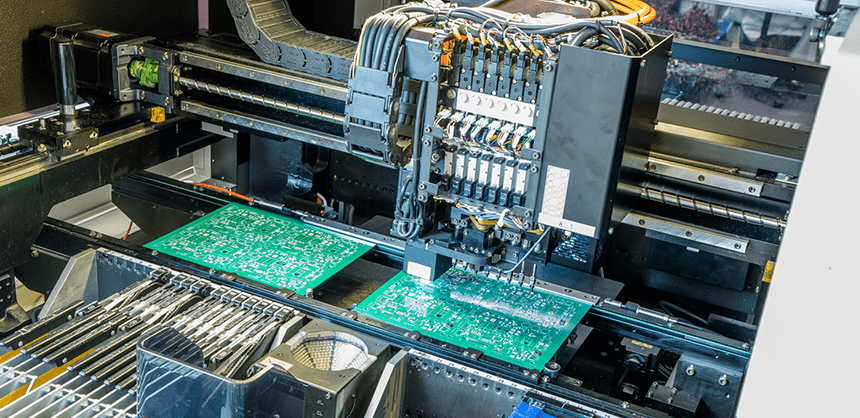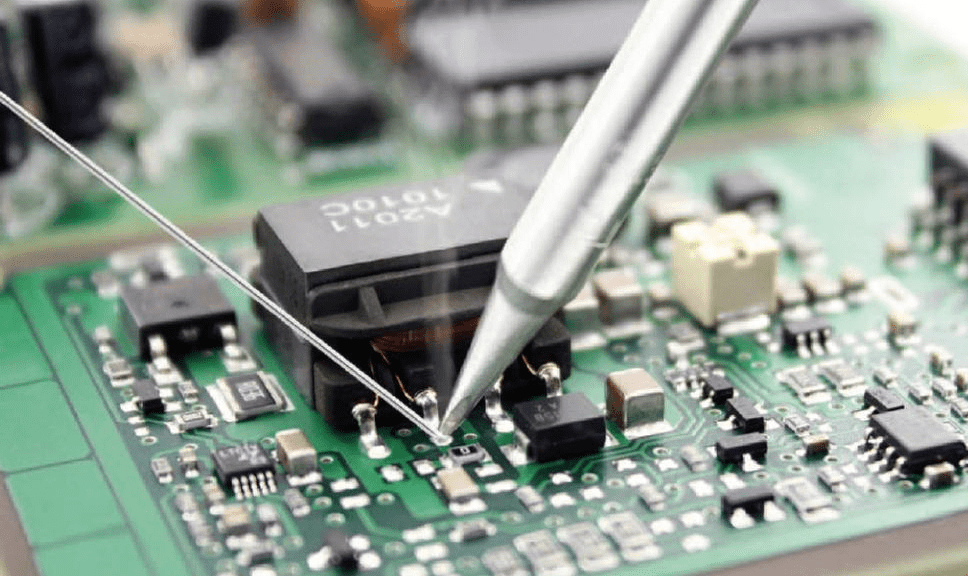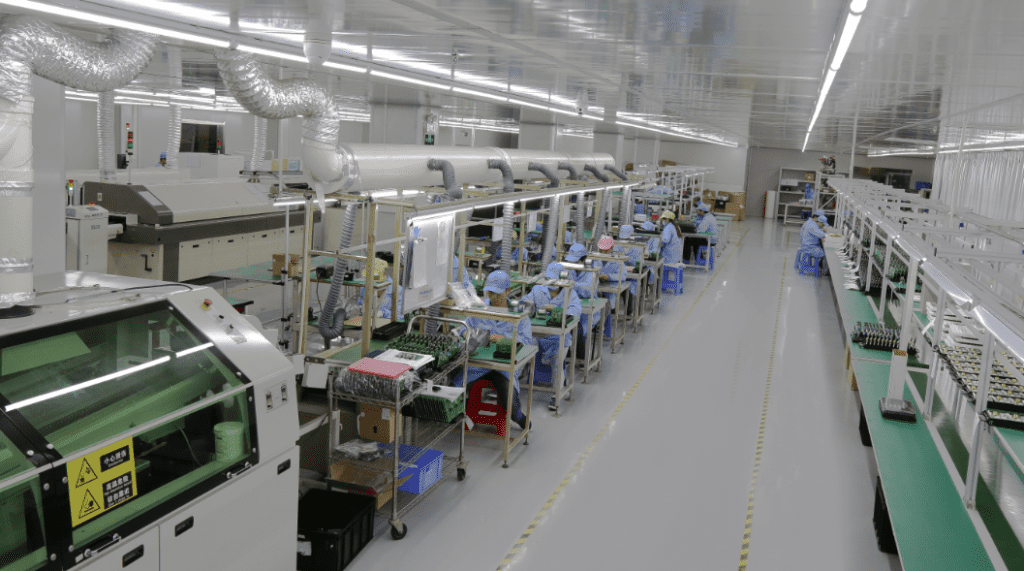It is crucial to know what SMT process entails to have a clear understanding of the SMT production line. SMT means surface mount technology. The SMT process simply involves mounting electronic components like resistors, integrated circuits, capacitors, resistors, transistors, and more on a printed circuit board. These surface mount devices (SMD) create electrical connections via wave soldering.
The surface mount devices are the components integrated by the surface mount technology. Therefore, the one can define the SMT line as a circuit board assembly line that comprises pieces of surface mount technology equipment like component placement machines, cleaning machines, welding machines, testing equipment, etc. SMT line can also be referred to as SMT assembly line.

What is SMT Production Line?
SMT production line is simply defined as a circuit board assembly line that comprises pieces of surface mount technology equipment. The surface mount technology is the most recent technology used in manufacturing circuit boards. Some years back, PCB manufacturers make circuit using wires. This made electronic product very big and hard to carry about. However, the advent of SMT has made it possible to produce compact circuits. When people invented the circuit board, electrical and electronic products started becoming smaller. All thanks to the surface mount technology that made it easy to embed electronic components in this circuit.
Traditional electronic components are just a few tenths of the components directly mounted on to the surface of the printed circuit board. One of the greatest benefits of using SMT line is the improvement of the quality of a product a lot. While reducing the whole production cycle, the quality of the products is improved. This is a great advantage for customers.
The X-ray machine is one of the inspection machines commonly used in SMT production. This machine helps in inspecting the quality of solder quality of BGA components.
Types of SMT Production Line
You can classify the SMT production line in two categories, based on the degree of automation. The two types of SMT production line are automatic production lines and semi-automatic production lines. Also, one can classify the production line into small, medium, and large production lines based on the size of the production line.
The automatic production line is a type of SMT production line that is completely equipped with automatic machines. Also, the SMT line consists of the automatic board machine, unloading machine, and buffer cable. Other machines include pick and place machine, AOI machine, automatic SMT stencil printer, PCB loader, PCB conveyor, and SMT reflow oven among others
The other type of SMT line is the semi-automatic production line. Here, the main production equipment is partially automatic. This production line includes machines like semi auto PCB conveyor, pick and place machine, semi auto AOI, reflow oven, etc.
What Does SMT Line Comprise?
There is a wide range of innovative and sophisticated machinery used in the fabrication of printed circuit boards. Also, SMT production consists of different advanced machines that make the SMT production process faster. Below are several machines used in the complete SMT production line.
Reflow oven
Reflow soldering is an important stage in SMT production. The reflow oven requires several zones in which temperatures can be easily and perfectly controlled. Also, the circuit board passes through the reflow oven to ensure that the solder paste transforms into molten solder before it cools off and solidify.
Laser making machine
The laser marking machine helps PCB manufacturers to mark positions accurately.
SMT stencil printers
SMT stencil printers are important machines in the SMT production line. The solder printing machine comprise solder paste and helps to spread solder paste evenly on the PCB surface. Also, the solder paste is a mixture of solder and flux. Therefore, it is important to apply this paste with high accuracy.
AOI inspection equipment
The automation optical inspection machine helps to detect any possible errors in the PCB. This machines uses an automated process to which eliminate human error.
3D Solder Paste Inspection machine
It is important to carefully carry out every stage in the SMT production process. The 3D solder paste inspection machine offers full inspection coverage. Also, it ensures the appropriate amount of paste deposits on the circuit.
Curing machine
In PCB production, post-curing is very crucial. Also, this process enables the prints to get to the maximum hardness required.
Curve PCB cutting machine
This machine is a multi-purpose high speed milling contiguous board. It helps in improving the quality of the printed circuit board. Also, it reduces scrap rate.
Benefits of SMT Production Lines

There are several benefits of SMT production lines benefits
It is safe
SMT line makes the SMT production much safer as it ensures the worker has less direct contact with machines. These machines are usually automated, so, they require less monitoring. This helps to minimize the risk of injury.
Saves cost
SMT line minimizes the need for labor. The use of various SMT machines in SMT production process reduces the need for manual labor. Over the years, labor cost has become so expensive. This is becoming a major concern for PCB producers. However, the use of SMT line has helped to save the cost of labor.
Furthermore, in SMT line, the production steps are usually connected in the entire line. Therefore, there is no need of storing semi-finished component during the manufacturing process. So, the entire process can help to minimize space of storing the material and as well as the finished goods. The cost of renting a space for storing materials and finished goods is becoming expensive.
Also, due to the reduction in the time it takes to complete the production cycle it is easy to get your payment on time. This will help you reduce the financial cost to an extent. The factory will also be able to keep cash in hand as this is important for the operation of the factory.
If the cost of production is lower, your product will be less expensive. This will make your product more competitive in the market.
High efficiency
The SMT production line helps to improve efficiency. This is because it ensures the SMT production process progresses from one step to another. It allows smooth operation. Also, it enhances the production process and this will result in fast turnaround time.
Main Applications of SMT Line
The SMT production line is beneficial to several applications.
Semiconductor Industry
Semiconductor production and SMT production are two independent fields. The development of the packaging technology has made these two fields important in the electronic industry. Semiconductor packaging companies integrate SMT mounters. These mounters are ideal for passive component. Also, these companies connect chips with the help of semiconductor die bonders. Chips are mainly considered as the primary products of semiconductor production. Therefore, there is a high demand for chip accuracy. A large number of chip manufacturers are integrating and combining die bonder plants.
Automotive Electronics Industry
Automobile producers are now manufacturing more intelligent vehicles these days. Modern cars now have highly intelligent features because they feature electronic systems. These electronic systems help them manage all their parts. Also, automotive producers started integrating SMT lines to meet the increasing demand to produce these modern cars in large quantities.
Consumer electronics
Also, SMT line has proved to be very useful in the mass production of the components of electronic consumer products. For example, the use of SMT line has aided the production of consumer electronics like washing , sound systems, TVs, and video game consoles among others.
LED Industry (Lighting)
The LED industry also benefits from SMT production line. LEDs have now become the lighting standard in our world today. This can be majorly attributed their durability and high level of efficiency.
SMT Production Process

Solder paste screening
The solder paste printer is the machine used in this step. The application of solder paste is the actual first step in the SMT production process. In this step, the stainless-steel stencil fits over the bare board, which leaves only the SMT pads uncovered. After this, a mechanical fixture holds the stencil in place. An applicator deposits the solder paste on the spaces that weren’t covered. It is important to inspect this step so as to ensure solder paste is only deposited in the necessary areas. Also, an appropriate amount of solder paste should cover the pads.
Component Placement
This is the next step after the applying the solder paste on the bare circuits. An automated pick and place machine helps to complete this process. This machine mounts the surface mount components in appropriate locations. In SMT assembly, component placement is entirely automated to ensure a high level of efficiency and maximum accuracy. After placing the components, there is need for inspection. This helps to ensure all components are appropriately placed and all placements are accurate. Depending on the type of project, you might need to perform this step several times.
Reflow Soldering
After the application of paste underneath pads and the placement of parts, it is time for the circuit boards to pass through the reflow oven. There are different soldering methods. However, the reflow soldering is the most common method for SMT assembly. This owns to the fact that reflow soldering is more flexible as regards PCB layout requirements. Therefore, it is a much better option than wave soldering or manual soldering. PCB assembly companies integrate reflow soldering for most of the components on the circuit boards. The assembler will have to reflow the boards once for each side for double-sided boards.
In reflow soldering, the components will need to withstand extreme heat for a longer period of time. However, this is not the case in wave or manual soldering. While most modern SMT components have the capability to withstand this heat, many through-hole components are not designed to meet the demands of reflow soldering.
X-ray inspection
The SMT X-ray machine helps to complete this step. Boards having lead-less package types need to undergo X-ray inspection. X-ray inspection detects possible defects in PCB assembly. The X-ray machine penetrates the board and creates an image of the solder joints. Also, the X-ray image can detect the cause of a particular defect like skewed part placement.
Final inspection
Inspections are crucial at every stage of PCB assembly. However these inspections aren’t enough. Therefore, a final inspection in which the fully assembled board is properly evaluated is crucial. The final inspections include visual inspection, AOI, In-circuit testing, etc.
Other Soldering Methods in PCB Assembly

Manual Soldering
Manual soldering is usually incorporated when a PCB design has parts not ideal for wave soldering or reflow soldering. For instance, some surface mount boards have a few THT components. Wave soldering would increase the cost of production. Therefore, manual soldering is a great option for this. Manual soldering is a method of soldering through hole components to a circuit board. This soldering involves the use of soldering iron.
Wave soldering
This soldering method involves passing the circuit boards through a conveyor with a wave of molten solder. The use of wave soldering has declined over the years. The increasing popularity of SMT parts and HDI board layouts is one of the reasons PCB assemblers are integrating reflow soldering. However, some PCB assemblers still use wave soldering. One of the advantages of wave soldering is that it enhances the mass production of circuit boards. Therefore, it is widely regarded as a bulk soldering process.
Why SMT Testing is Important
SMT inspection plays a very crucial role in SMT production. It helps to improve the functionality and quality of SMT products. Also, it helps in achieving “no defect.” It will cost more to correct a fault or build another circuit board if the fully assembled board has some defects. Therefore, SMT testing helps to avoid any form of errors during and after SMT production.
It is important to perform effective testing to verify the quality and functionality of SMT products. Also, SMT testing helps in detecting defects timely correcting these defects through repair or replacement. In the long run, this significantly minimizes the occurrence of failures in circuit boards.
Another reason for SMT testing is that more and more components becoming smaller. The human eyes can’t identify some of these components. For instance, SMD 0201 and 01005 are very small. Therefore, it is difficult for human eyes to see the model number. The solder paste printer deposits an appropriate amount of solder. SMT testing involves inspecting the amount of solder deposited by the solder paste printer.
Types of Testing in SMT Production
In-circuit testing (ICT)
ICT is a robust testing method commonly used in SMT process. This test is mostly designed for 100 percent coverage. Also, ICT involves the use of fixed probes that matches the PCB design. ICT can detect common defects like missing components, poor soldering, solder shorts, and more.
AOI
The automated optical inspection is the most popular testing method integrated in SMT production. The AOI machine makes use of two 3D cameras and one 2D camera to capture images of the PCB. If the circuit doesn’t correspond with the schematic to a particular degree, the board will need further inspection. Also, AOI helps to detect any defect early.
Functional testing
This is another type of testing carried out in SMT production. Also, functional testing requires fixtures and external pieces of the equipment. The customer provides the parameters. The functional testing machine checks the actual behavior of the PCB and determines if it passes or fails.
X-ray inspection
This inspection method is widely used in SMT production. It detects possible defects that the AOI can’t detect. For instance, automated x-ray inspection can inspect solder connections under BGA packages.
Development Trends of SMT line

There are several development trends in SMT lines.
Computer Integrated Manufacturing Systems (CIMS)
The Computer Integrated Manufacturing Systems play a crucial role in connecting the design and production processes to minimize the time it takes to prepare for SMT production. In the long run, this helps to reduce the total time spent on whole SMT manufacturing process.
Environmental Protection
Items such as glue, flux, packaging materials, and solder paste are basically used in during the SMT process. These items could possibly cause pollution in the environment. PCB manufacturers and assemblers are now integrating environmentally-friendly methods in this process. Also, they carry out analysis on the pollution sources and how much they appear in the assembly process. This analysis helps to employ methods to reduce their impact on the environment.
Efficiency Improvement
Efficiency usually results in higher output. Also, efficiency is important during SMT production process. SMT lines are beginning to eliminate the human element. The implementation of the centralized online management control systems is another way to improve efficiency in SMT line.
Flexible Information Integration Production Environment
Internet development and grid info technology offer product data management to help enhance SMT production lines. Furthermore, they improve maintenance management. They will also create a flexible information integration manufacturing environment for all SMT lines.
Conclusion
SMT lines are crucial in the SMT assembly process. These lines comprise a wide range of machines offering various functions. Some of these machines include solder printing machine, reflow oven, and laser making machine among others. Also, SMT lines are crucial production lines in the PCB assembly process. We have discussed every important detail about the SMT line in this article.


